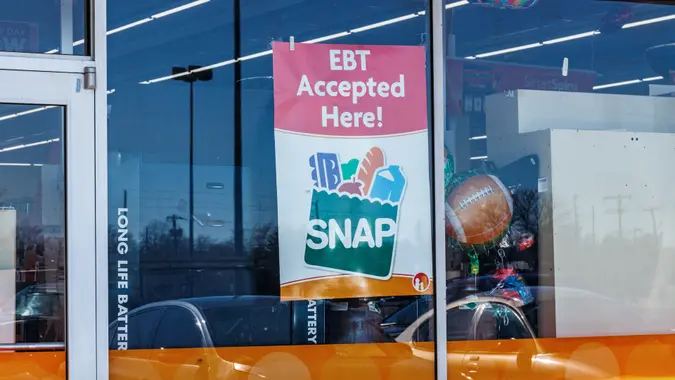4 Ways Gen Z Can Protect Themselves From Financial Scams

Commitment to Our Readers
GOBankingRates' editorial team is committed to bringing you unbiased reviews and information. We use data-driven methodologies to evaluate financial products and services - our reviews and ratings are not influenced by advertisers. You can read more about our editorial guidelines and our products and services review methodology.

20 Years
Helping You Live Richer

Reviewed
by Experts

Trusted by
Millions of Readers
According to a recent survey from GOBankingRates, Gen Z is the most likely age group to fall victim to financial scams. Out of those surveyed, only 31% of individuals ages 18 to 24 say they have never fallen for a scam, a low number when compared to nearly 38% for ages 25 to 34 and 41% for ages 41 to 54. The study found that Gen Z is more likely to fall for various financial scams, including phone scams, Social Security scams and student loan forgiveness scams.
People born 1997 to 2012, more commonly referred to as Gen Z, are an incredibly tech-savvy age group, making them a prominent target for scammers. Their increased digital activity, limited financial knowledge and social media use can make them more susceptible to financial scams.
“Gen Z is generally more comfortable with technology, including online transactions,” said Joseph Bernardo, global head of fraud and claim operations with Wells Fargo. “Ironically, that familiarity in the digital space can sometimes lead to overconfidence and less caution when dealing and transacting in the digital realm. When your guard is down, you can become more susceptible to scams.”
Additionally, their heavy social media use can expose Gen Z to scams via phishing links, fake accounts and deceptive ads. Also, as the youngest adult generation, Gen Z individuals are still becoming financially educated and may be more vulnerable to certain scams, such as get-rich-quick schemes.
Fortunately, there are several ways that Gen Z can protect themselves from financial scams and learn to recognize them.
Protect Your Personal Information
One of the most important things Gen Z can do to protect themselves from a financial scam is to always monitor and protect their personal information. Things like usernames, passwords, PINs or one-time passcodes should never be shared with anyone.
Make Sure You Trust the Recipient
If an unknown person is reaching out to you and requesting money or private information, never trust these sources.
“Don’t trust caller ID,” Bernardo said. “Scammers can ‘spoof’ legitimate phone numbers by altering caller ID.”
Furthermore, institutions such as your bank will never request these things over the phone.
“Don’t send money to people you don’t know or can’t confirm as legitimate,” Bernardo said.
Verify That Websites and Emails Are Legitimate
Similar to unknown callers, it’s important to verify that email addresses and websites are authentic contacts. With websites, there are several things to look for to ensure that they can be trusted for sending money.
“Make sure the URL is a real, legitimate website and if making an online payment, look for the padlock icon symbolizing a secure site,” Bernardo said.
It’s also crucial to avoid clicking on any links from unsolicited emails, text messages or online ads.
“This could be a phishing ploy and can be a way for scammers to install malware on your device or send you to a fraudulent site,” Bernardo said.
Use Caution When Scanning QR Codes
While QR codes are an efficient tool for legitimate businesses or sellers, Gen Z should be aware that QR codes can also be used by scammers to send you to a fake or malicious website where they will steal your payment or personal information.
Red Flags for Gen Z To Consider
When it comes to financial scams, there are several red flags that Gen Z can look for to tell if something is a scam. For instance, if an online marketplace is featuring offers or deals that seem too good to be true, then it’s best to avoid it. Additionally, unknown sellers on social media and unknown websites may also be financial scammers.
Also, unusual payment requests in the form of cryptocurrency, gift cards, prepaid cards or wire transfers are another financial scam red flag. These are immediate forms of payment and are usually irreversible, making them a common ploy for scammers. The same can be said for purchases that may require you to leave a website to make a payment on another unsecured platform.
One telltale sign of a scam is if an unknown person is reaching out to you asking for money with a strong sense of urgency. Anybody asking you to send money immediately or requesting immediate access to your bank account or personal information is one of the most prominent signs of a scam.
“Phishing scams can come via text, email or phone calls, and often use an urgent tone to push you to act quickly,” Bernardo said. “These solicitations may pose as someone you know or as a legitimate organization and ask for an immediate payment, sensitive information or request you click open a malicious link.”
If Gen Zers are looking to protect themselves from financial scams, vigilance and awareness are two key things to keep in mind.
“When asked to act immediately, do the opposite,” Bernardo said. “Wait until you can validate.”
How Gen Z Can Educate Themselves on Scams and Fraud
One of the biggest reasons that Gen Z is more susceptible to financial scams is that they are less financially experienced and educated than older generations. However, there are several ways that Gen Z can improve their financial knowledge and be more wary of potential schemes.
It may be beneficial for Gen Z to download their banking app on their phone so that they can constantly monitor their account and spending activity. When doing so, you can also set up account alerts so that you are immediately notified when suspicious activity is detected.
Furthermore, knowing and understanding the security features and resources provided by your financial institution as well as having conversations with a trusted network or financial institution can help Gen Zers to be more prepared when it comes to financial scams and fraud.
More From GOBankingRates
 Written by
Written by  Edited by
Edited by 

























